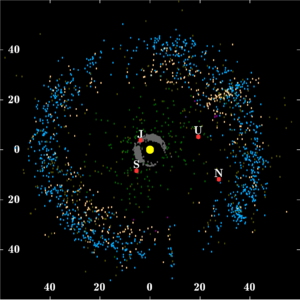Write4U
Valued Senior Member
No, read Paddo's quoted passage of Abstract, in Post #1, about the volatile materials, which until then I had not even considered at all, but his post started the mutual analysis of known evidence.I think you're confused.
My initial point was that Theia was big enough to deliver sufficient amounts of water to create our current oceans.
AFAIK, early Earth did not have a lot of water , if any at all.
p.p.s. From Post #16
https://en.wikipedia.org/wiki/Theia_(planet)Additional evidence published in 2019 suggests that Theia might have formed in the outer Solar System rather than the inner Solar System, thus making it analogous to a Kuiper-Belt object like Pluto, and that much of Earth's water originated on Theia

Known objects in the Kuiper belt beyond the orbit of Neptune. (Scale in AU; epoch as of January 2015.)
https://en.wikipedia.org/wiki/Kuiper_belt
Last edited:
